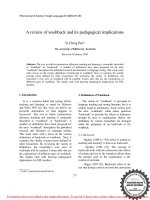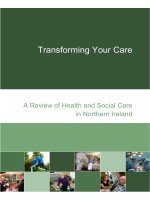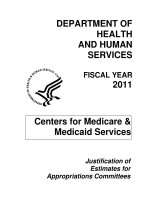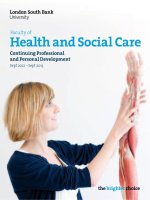Transforming Your Care A Review of Health and Social Care in Northern Ireland pptx
Bạn đang xem bản rút gọn của tài liệu. Xem và tải ngay bản đầy đủ của tài liệu tại đây (4.87 MB, 213 trang )
Transforming Your Care
A Review of Health and Social Care
in Northern Ireland
Transforming Your Care
A Review of Health and Social Care
in Northern Ireland
December 2011
1
1.
INTRODUCTION ........................................................................................... 1
2.
EXECUTIVE SUMMARY ............................................................................... 3
3.
BACKGROUND TO THE REVIEW............................................................... 10
4.
THE CASE FOR CHANGE ........................................................................... 18
5.
THE PRINCIPLES FOR CHANGE ............................................................... 37
6.
A FUTURE MODEL FOR INTEGRATED HEALTH AND SOCIAL CARE ...... 43
7.
POPULATION HEALTH AND WELLBEING ................................................. 54
8.
OLDER PEOPLE ......................................................................................... 59
9.
LONG TERM CONDITIONS......................................................................... 71
10. PEOPLE WITH A PHYSICAL DISABILIITY .................................................. 78
11. MATERNITY AND CHILD HEALTH ............................................................. 82
12. FAMILY AND CHILD CARE ......................................................................... 85
13. PEOPLE USING MENTAL HEALTH SERVICES ......................................... 89
14. PEOPLE WITH A LEARNING DISABILITY .................................................. 94
15. ACUTE CARE .............................................................................................. 98
16. PALLIATIVE AND END OF LIFE CARE ..................................................... 110
17. IMPLICATIONS FOR THE SERVICE ......................................................... 114
18. ROADMAP FOR THE FUTURE ................................................................. 129
19. SUMMARY OF PROPOSALS .................................................................... 135
20. CONCLUSION ........................................................................................... 142
21. APPENDIX ................................................................................................. 143
The Review Team would like to thank the Project Team:
Pamela McCreedy – Project Leader
Angela Hodkinson, Elaine Hunter, Seamus Carey – Project Managers
Ffiona Dunbar, Maria Higgins, Jonathan Houston – Project Support
1. INT RODUCT ION
The task faced by the Review was both challenging and daunting. Health and Social Care is
of interest to everyone in Northern Ireland and the team approached their task fully aware of
the responsibility it had been given.
It was also aware that whilst it was important to look to best practice and examine data from
outside the province the deliberations had, in the end, to make sense for Northern Ireland.
Many drivers exist in this context: the importance of health and social care to the economic
wellbeing of NI; the contribution staff make; the shadow of our recent history in NI, particularly
in the mental well being of the citizenry; and the very powerful affinity the NI society has to
the core NHS principles.
The team approached its task with that knowledge and these matters were reflected
exhaustively in their deliberations. However, the overriding desire of the team was to
describe and build a system of health and social care which would place the individual, family
and community that use it at the heart of how things are done. That meant using evidence to
explain why there needs to be change and concentrate on the outcomes that individuals
could reasonably expect in a modern system of care and treatment.
The Review is therefore about change; not careless or haphazard change but planned
change over a 5 year period that can and should improve care. The report may be
contentious to some, but the Review team saw clearly that there are no neutral decisions as it
looks to the future. It has taken the view that a managed and transparent change is better
than unplanned, disorganised change.
Finally on behalf of the team I should like to thank the very many people, citizens,
professionals and representatives of interest groups who gave freely of their time to help the
Review. I should also like to extend thanks to the independent panel members for their
honesty, challenge and contribution to the Review.
John Compton
Chair of the Review Team
December 2011
1
EXECUTIVE
SUMMARY
2
2. EXECUT IVE SUMMARY
In June 2011, the Minister for Health,
Social Services and Public Safety, Edwin
Poots, MLA, announced that a Review of
the Provision of Health and Social Care
(HSC) Services in Northern Ireland would
be undertaken. The Review was to
provide a strategic assessment across all
aspects of health and social care
services, examining the present quality
and accessibility of services, and the
extent to which the needs of patients,
clients, carers and communities are being
met. Crucially it was to bring forward
recommendations for the future shape of
services and provide an implementation
plan. The Review team was not asked to
bring forward proposals which reduced
the budget published by the Northern
Ireland Executive, but was asked to
ensure that it was used to best effect.
The Minister judged that at a time of
considerable flux within health and social
care and the wider economy it was
prudent not to disconnect the service from
the Review process. Therefore, he
appointed John Compton, Chief Executive
of the Health and Social Care Board, to
complete the task in an ex-officio
capacity. However, the Minister did want
a strong independent overview to the
process, helping to shape and providing
challenge to any proposals. Therefore he
also appointed an independent panel
comprising: Professor Chris Ham (Chief
Executive of the King’s Fund), Professor
Deirdre Heenan (Provost and Dean of
3
Academic Development at the Magee
Campus), Dr Ian Rutter (General
Practitioner), Mr Paul Simpson (retired
senior civil servant), and Mr Mark Ennis
(Executive Chair of SSE Ireland).
The Review was to complete by 30
November 2011. Within the timescale
available, the Minister was keen to ensure
maximum engagement with the public,
clinical and professional leaders, health
and social care organisations and
stakeholders in the voluntary, community,
private and independent sectors. In
particular the Minister highlighted the
importance of engaging with the health
and social care workforce through the
Partnership Forum. Following their
appointment in August, the Review team
designed its approach as shown below.
Figure 1: Overview of Approach
1. Review of Context & Good
Practice
2. Assessment of Existing
Arrangements
3.Assessment of Alternative
Options / Models of Service
Delivery
4. Analysis and Reporting
5. Engagement
The Review concluded that there was an
unassailable case for change. The figure
below illustrates the core of the argument.
Figure 2: Future Model for Integrated
Health and Social Care
Consequences
Unplanned &
Haphazard
Change
A Growing &
Ageing Population
Poorer
Health and
Growth in
Chronic
Conditions
Instability in the
Health and Social
Care System
Poorer Health
Outcomes
Difficulties
Meeting Future
Health Needs
Increasing Pressure on Health and Social Care
Responding to these pressures, the
Review identified eleven key reasons
which support the need for change
(summarised in the adjacent box) along
with a model of health and social care
which would drive the future shape and
direction of the service.
Poorer Care &
Treatment
Failing the
Health and
Social Care
Workforce
Figure 3: Reasons for Change
To be better at preventing ill health
To provide patient-centred care
To manage increasing demand across all
programmes of care
To tackle health inequalities
To deliver a high-quality, evidence-based
service
To support our workforce in delivering the
necessary change
4
In developing a new model, the Review
engaged with over 3000 members of the
public, clinicians, providers and interest
groups. It also reviewed evidence to
ensure that any changes required had at
their heart better outcomes for patients
and clients and their families.
The Review was clear about the purpose
of change namely, what changes would
make the greatest difference to outcomes
for patients, users and carers. In doing so
the Review looked beyond the
geographical boundaries of Northern
Ireland.
The Review identified twelve major
principles for change, which should
underpin the shape of the future model
proposed for health and social care.
1. Placing the individual at the centre of
any model by promoting a better
outcome for the service user, carer
and their family.
2. Using outcomes and quality evidence
to shape services.
3. Providing the right care in the right
place at the right time.
4. Population-based planning of services.
5. A focus on prevention and tackling
inequalities.
6. Integrated care – working together.
7. Promoting independence and
personalisation of care.
8. Safeguarding the most vulnerable.
5
9. Ensuring sustainability of service
provision.
10. Realising value for money.
11. Maximising the use of technology.
12. Incentivising innovation at a local level.
The model devised by the Review team is
shown in the figure overleaf.
Figure 4: Future Model for Integrated
Health and Social Care
24/7
Emergency
Care
Consultant
Led Acute
Services
Diagnostics
Day
Procedures
Local
Services
GP
Services
Pharmacy
Step Up/
Step Down
Care
Diagnostics
Social
Care
Obstetrics
Individual
Mental
Health
Outpatients
Self Care &
u
Good Health
Decisions
Therapy and
Rehab
Emergency
Medicine
Emergency
Surgery
Dentistry
Optometry
Support for
Carers
Urgent Care
Health Visitor
District
Nursing
Allied Health
Professionals
Other
Specialist
Cancer
Services
Briefly described the model means:
•
6
Elective
Inpatient
every individual will have the
opportunity to make decisions that
help maintain good health and
wellbeing. Health and social care will
provide the tools and support people
need to do this;
Paediatrics
•
most services will be provided locally,
for example diagnostics, outpatients
and urgent care, and local services will
be better joined up with specialist
hospital services;
•
services will regard home as the hub
and be enabled to ensure people can
be cared for at home, including at the
end of life;
•
•
•
the professionals providing health and
social care services will be required to
work together in a much more
integrated way to plan and deliver
consistently high quality care for
patients;
where specialist hospital care is
required it will be available,
discharging patients into the care of
local services as soon as their health
and care needs permit; and
some very specialist services needed
by a small number of people will be
provided on a planned basis in the
ROI and other parts of the UK.
To help illustrate what this would mean,
case studies were developed to explain
the model. In essence they show it to be
simpler to use, clearer about the key
worker, and crucially providing an
improved outcome for those who use the
service.
Following on from this, the impact on ten
major areas of care was examined:
Population Health and Wellbeing
Older People
People with Long-Term Conditions
People with a Physical Disability
Maternity and Child Health
Family and Child Care
7
People using Mental Health Services
People with a Learning Disability
Acute Care
Palliative and End of Life Care
The model was applied to these service
areas and each has a series of
recommendations. The full list of 99
proposals is provided Section 19 of the
report.
The key themes in the recommendations
are summarised below.
Quality and outcomes to be the
determining factors in shaping services.
Prevention and enabling individual
responsibility for health and wellbeing.
Care to be provided as close to home as
practical.
Personalisation of care and more direct
control, including financial control, over
care for patients and carers.
Greater choice of service provision,
particularly non-institutional services,
using the independent sector, with
consequent major changes in the
residential sector.
New approach to pricing and regulation in
the nursing home sector.
Development of a coherent ‘Headstart’
programme for 0-5 year old children, to
include early years support for children
with a disability.
A major review of inpatient paediatrics.
In GB a population of 1.8million might
commonly have 4 acute hospitals. In NI
there are 10. Following the Review, and
over time, there are likely to be 5-7 major
hospital networks.
Establishment of a clinical forum to
ensure professionals are fully engaged in
the implementation of the new model.
A changing role for general practice
working in 17 Integrated Care
Partnerships across Northern Ireland.
Recognising the valuable role the
workforce will play in delivering the
outcomes.
Confirming the closure of long-stay
institutions in learning disability and
mental health with more impetus into
developing community services for these
groups.
Population planning and local
commissioning to be the central approach
for organising services and delivering
change.
8
Shifting resource from hospitals to enable
investment in community health and
social care services.
Modernising technological infrastructure
and support for the system.
Following from this, the Review
considered and presented the
methodology to make the change over a 5
year period.
This initially describes a financial
remodelling of how money is to be spent
indicating a shift of £83million from current
hospital spend and its reinvestment into
primary, community and social care
services. It goes on to describe as
integral the need for transitional funding of
£25million in the first year; £25million in
the second year; and £20 million in the
third year enable the new model of
service to be implemented
In conclusion, the Review reiterates that
change is not an option. It re-affirms
there are no neutral decisions and there is
a compelling need to make change. The
choice is stark: managed change or
unplanned, haphazard change. The
Review team commends its report to the
Minister.
BACKGROUND
TO THE REVIEW
9
3. BACKGROUND T O THE REVIEW
This part of the report explains the nature
and purpose of the Review. It sets out
who was involved and why, then
describes the objectives set for the
Review, the scope of the task and the
approach taken to complete it.
In June 2011, the Minister for Health,
Social Services and Public Safety, Edwin
Poots, MLA, announced that a Review of
the Provision of Health and Social Care
Services in Northern Ireland would be
undertaken, asking how it should change
and requesting an implementation plan to
manage the change. The full terms of
reference is included at Appendix 1.
The Review was not to be fully
independent and Mr John Compton, Chief
Executive of the Health and Social Care
Board, was invited to lead the process.
The Minister judged that at a time of
considerable flux within health and social
care and the wider economy it was
prudent not to disconnect the service from
the Review process. However he did
want a strong independent overview to
the process providing challenge to any
proposals. Accordingly he appointed five
independent panel members:
•
Professor Chris Ham (Chief Executive
of the King’s Fund);
•
Professor Deirdre Heenan (Provost
and Dean of Academic Development
at the Magee Campus, University of
Ulster);
•
Dr Ian Rutter (General Practitioner);
•
Paul Simpson (retired senior civil
servant); and
•
Mark Ennis (Executive Chair of SSE
Ireland).
The key objectives of the Review were
to:
•
undertake a strategic assessment
across all aspects of health and
social care services;
•
•
make recommendations to the
Minister on the future
configuration and delivery of
services; and
•
10
undertake appropriate
consultation and engagement on
the way ahead;
set out a specific implementation
plan for the changes that need to
be made in health and social care.
The appointments reflected the desire to
ensure proper scrutiny was applied to the
process.
The Minister’s over-riding concern is
driving up the quality of care for clients
and patients, improving outcomes and
enhancing the patient experience. In
initiating the Review, the Minister
explained that he wanted it to ensure that
health and social services are focused,
shaped and equipped to improve the
quality of care and outcomes for the
population, and to provide value for
money in financially challenging times.
He wants to see a shift in care currently
carried out in hospitals into the community
with patients being treated in the right
place, at the right time and by the right
people.
The Minister also made it clear that in
deciding to have a Review no criticism
was implied about staff working in the
current system. Quite the reverse, he
concluded that the current model was
unsustainable going forward and that he
wanted to see a service which was
developing not declining, a service which
built upon the commitment and expertise
of those working in health and social care.
accessibility, safety, standards, quality
of services and value for money;
•
undertake appropriate consultation
and engagement on the way ahead
with the public, political
representatives through the Assembly
Health Committee, HSC organisations,
clinical and professional leaders within
the system, staff representatives
through the Partnership Forum, and
stakeholders in the voluntary,
community, independent and private
sectors;
•
make recommendations to the Minister
on the future configuration and
delivery of services in hospital, primary
care, community and other settings;
and
•
set out a specific implementation plan
for the changes that need to be made
in the HSC, including proposals in
relation to major sites and specialities.
SCOPE
OBJ ECTIVES
In delivering these objectives the Review
was to take account of the following:
Accordingly the objectives of the Review
were to:
•
extant policy and strategies approved
by the Minister, in particular the aims
of improving public health, the
prevention of illness and of improving
outcomes for patients and clients;
•
statutory duties on the HSC to improve
the quality of services provided, to
improve the health and social
wellbeing of the population and to
reduce health inequalities; and
•
provide a strategic independent
assessment across all aspects of
health and social care services of the
present quality and accessibility of
services and the extent to which the
needs of patients, clients, carers and
communities are being met by existing
arrangements in terms of outcomes,
11
•
primary care, community care, social
care and hospital services.
Certain areas were deemed to be outside
the scope of the Review:
•
the new organisational structures
created as a result of the RPA process
within Health and Social Care; and
•
the Review should work within the
constraints of the current level of
funding for the coming period. The
current Performance and Efficiency
Unit (PEDU) review of the scope to
make savings in the health and social
care sector is separate from the HSC
Review and the development of an
implementation plan to deliver savings
will continue in parallel with this
Review.
However, the Minister indicated that if the
Review felt it should comment on any of
these areas, it should not feel constrained
in doing so.
Public health and social wellbeing is at the
heart of health and social care. The
12
Review team is aware that there is a
separate piece of work being undertaken
by the Department of Health Social
Services and Public Safety (DHSSPS)
and the Public Health Agency (PHA) to
create a new public health strategy, as set
by the Executive and Minister.
Notwithstanding this, the Review
considered it appropriate to look at public
health and wellbeing in its work.
The Terms of Reference had asked the
Review to make recommendation on the
future configuration of hospital, primary
care, community care and other settings.
During the course of the Review, the team
proposed to the Minister that it was better
to describe a framework for the future of
care rather than including specific
proposals in relation to sites and
specialties. The rationale for this
presented to the Minister was the critical
need to enable professionals and
communities to devise local solutions
within a very clear framework and criteria
for success. The Minister agreed to this
approach to applying the Terms of
Reference.
APPROACH
Giving consideration to the Terms of
Reference set by the Minister (Appendix
1), a project plan was developed. The
approach to the Review involved five key
strands of activity, as shown in the figure
below.
This resulted in more than 3,000 people
engaging directly with the Review, and
many more being exposed to debate on
the key issues affecting health and social
care provision through media coverage of
the Review on TV, radio, online and by
the printed media.
Figure 5: Overview of Approach
1. Review of Context & Good Practice
- Review of Literature, Benchmarks, Good
Practice
2. Assessment of Existing Arrangements
- Analysis of Current Provision, Economic
Impact, Drivers for Change
3. Assessment of Alternative Options /
Models of Service Delivery
- Identification of Key Principles for Service
Delivery & Potential Options for Change
4. Analysis and Reporting
- Consolidation of Submissions & Inputs to the
Review, Development of Report
5. Engagement
– Meetings, Surveys, Workshops & Media
In particular the Minister highlighted the
importance of engagement with
stakeholders and a comprehensive
engagement plan was developed. The
objective was to enable informed debate
and to present information to the public.
13
The engagement plan for the Review
involved:
•
Engagement with local media to
promote press, television and radio
features on the Review to raise public
awareness of the issues involved and
stimulate debate. The BBC e-panel
received 641 views on aspects of the
health and social care system;
A series of sector workshops, with
representatives from the voluntary and
community sector (facilitated by the
Northern Ireland Council for Voluntary
Action), registered social care
workforce (facilitated by the Northern
Ireland Social Care Council), and
private sector (facilitated by the
Business Alliance) (see Appendix 6 for
details of attendees);
•
Small group meetings with a range
of stakeholders including HSC arm’s
length bodies, trade unions (via the
Partnership Forum), professional and
regulatory bodies, voluntary and
community sector organisations,
political representatives, independent
care providers, and colleagues within
health and social care in other parts of
the UK and the Republic of Ireland
(see Appendix 7 for a full list of the
stakeholders engaged with);
•
Submission of written responses to
the Review (see Appendix 8 for a list
of written submissions); and
•
Meetings with HSC Trusts’ Senior
Management Teams.
An online survey completed by 673
individuals, of which 91% worked for
an organisation providing health and
social care (see Appendix 2 for a
summary of results);
•
•
•
A household survey (completed by
IpsosMORI) of 1,009 adults aged over
16, selected to be representative of
the Northern Ireland population in
terms of gender, age, social class and
geography (see Appendix 3 for a
summary of results);
•
Six public meetings were held in
Londonderry, Omagh, Ballymena,
Belfast, Lisburn and Armagh. These
were facilitated by the Patient and
Client Council (PCC). (See Appendix
4 for details of the questions raised
during the meetings);
•
A series of workshops with
clinicians from HSC Trusts, General
Practitioners (GPs) and HSC
managers to discuss current provision
and future needs of specific service
areas (see Appendix 5 for details of
attendees and areas covered at each
workshop);
14
A Glossary is included in Appendix 9.
An overview of the stakeholders engaged
with throughout the review is shown in the
figure below.
Figure 6: Engagement during the Review
Household
Survey: 1,000
members of the
public
Clinical
Workshops:
approx. 300
participants
Media Coverage:
Press, TV, Radio &
online - record
number of hits on
BBC Facebook
page
Online
Survey:
completed by
673 public and
staff
Engagement
During the
Review
HSC Trusts:
approx. 135
from Trust
Management
Teams
15
Meetings:
approx. 100
staff-side,
providers &
charity
sector
Workshops:
approx. 200
from NICVA,
NISCC,
Business
Alliance
Public
Meetings:
approx. 400
attending
STRUCTURE OF REPORT
This report begins by outlining the
reasons why our health and social care
system needs to change, based upon the
evidence that the Review has collected
during the Review process. It then sets
out the principles the Review considers
should underpin this change.
A new model of care is described and
contrasted with the existing model of care
using case studies. The report details the
impact of the new model across 10 areas
of care.
Population Health and Wellbeing
Older People
People with Long-Term Conditions
People with a Physical Disability
Maternity and Child Health
Family and Child Care
People using Mental Health Services
People with a Learning Disability
Acute Care
Palliative and End of Life Care
16
It moves on to describe the implications
for the health and social care system. This
takes account of integrated working
across health and social care, workforce
issues and enhanced use of technology.
Finally, an implementation roadmap
outlines how this change will be
implemented and delivered over a five
year period.
THE CASE FOR
CHANGE
17
4. THE CASE FOR CHANGE
Making the case for change is at the
centre of this Review. It is not a critique
of the current provision but rather a
fundamental recognition that the existing
model of care is not fit for purpose as one
looks to the future.
The figure below illustrates the pressures
currently facing the system and the
potential consequences of doing nothing.
There are no neutral decisions in this
regard. If we do nothing, the system will
not be able, in its current form, to continue
to deliver a high quality service that will
meet the needs of the population.
Figure 7: Pressure facing the system
The fundamental changes to our
population in terms of age and need are
clear. We must design a model which
acknowledges this and is based on the
needs of this changing population rather
than its historic configuration. If we do not
plan to change the system we will
continue to be faced with unplanned
changes that will not be in the best
interest of the patient. This will result in a
prioritisation of who gets care and a
reduction in access to many important
services for a large proportion of our
population.
We have a highly skilled and dedicated
workforce who are being failed by a
system which is no longer fit for purpose.
This has resulted in staff working within a
system which does not deliver the quality
Consequences
Unplanned &
Haphazard
Change
A Growing &
Ageing Population
Poorer
Health and
Growth in
Chronic
Conditions
Instability in the
Health and Social
Care System
Increasing Pressure on Health and Social Care
18
Poorer Care &
Treatment
Poorer Health
Outcomes
Difficulties
Meeting Future
Health Needs
Failing the
Health and
Social Care
Workforce
of service to which they strive.
The Review also acknowledges that
throughout this process everyone spoken
to has asked the Review to promote the
‘making it better’ principle and has
affirmed that it can be better.
W HY DO WE NEED CHANGE?
Despite the many positive aspects of the
current model of health and social care,
compelling factors reflect the need for
change:
•
a growing and ageing population;
•
increased prevalence of long term
conditions;
•
increased demand and over reliance
on hospital beds;
•
clinical workforce supply difficulties
which have put pressure on service
resilience; and
•
the need for greater productivity and
value for money.
Against this backdrop, the Review
identified 11 keys reasons supporting
change. In a new model, how these are
responded to will be key to shaping the
decisions for the future configuration of
specific services.
Reason 1 – The need to be better at
preventing ill health
Reason 2 - The importance of patient
centred care
Reason 3 – Increasing demand in all
programmes of care
Reason 4 – Current inequalities in the
health of the population
Reason 5 – Giving our children the best
start in life
Reason 6 – Sustainability and quality of
hospital services
Reason 7 – The need to deliver a high
quality service based on evidence
Reason 8 – The need to meet the
expectations of the people of NI
Reason 9 – Making best use of resources
available
Reason 10 – Maximising the potential of
technology
Reason 11 – Supporting our workforce
19









